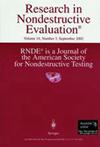Quantile POD for nondestructive evaluation with hit--miss data
IF 1.6
4区 材料科学
Q3 MATERIALS SCIENCE, CHARACTERIZATION & TESTING
引用次数: 2
Abstract
ABSTRACT Probability of detection (POD) is commonly used to measure a nondestructive evaluation (NDE) inspection procedure’s performance. Due to inherent variability in the inspection procedure caused by variability in factors such as crack morphology and operators, it is important, for some purposes, to model POD as a random function. Traditionally, inspection variabilities are pooled and an estimate of the mean POD (averaged over all sources of variability) is reported. In some applications it is important to know how poor typical inspections might be, and this question is answered by estimating a quantile of the POD distribution. This article shows how to fit and compare different models to repeated-measures hit--miss data with multiple inspections with different operators for each crack and shows how to estimate the mean POD as well as quantiles of the POD distribution for binary (hit--miss) NDE data. We also show how to compute credible intervals (quantifying uncertainty due to limited data) for these quantities using a Bayesian estimation approach. We use NDE for the detection of fatigue cracks as the motivating example, but the concepts apply more generally to other NDE applications areas.使用命中-未命中数据进行无损评估的分位数POD
摘要:检测概率(POD)通常用来衡量无损检测过程的性能。由于裂纹形态和操作人员等因素的可变性导致检测过程中固有的可变性,因此将POD建模为随机函数对于某些目的很重要。传统上,检验的可变性是汇总和平均POD(所有可变性来源的平均值)的估计是报告的。在某些应用程序中,了解典型检查可能有多差是很重要的,这个问题可以通过估计POD分布的分位数来回答。本文展示了如何通过对每个裂缝使用不同操作符进行多次检查来拟合和比较不同的模型,以适应重复测量的命中-未命中数据,并展示了如何估计二元(命中-未命中)NDE数据的POD分布的平均值和分位数。我们还展示了如何使用贝叶斯估计方法计算这些数量的可信区间(量化由于有限数据造成的不确定性)。我们使用无损检测来检测疲劳裂纹作为激励的例子,但这些概念更普遍地适用于其他无损检测应用领域。
本文章由计算机程序翻译,如有差异,请以英文原文为准。
求助全文
约1分钟内获得全文
求助全文
来源期刊

Research in Nondestructive Evaluation
工程技术-材料科学:表征与测试
CiteScore
2.30
自引率
0.00%
发文量
14
审稿时长
>12 weeks
期刊介绍:
Research in Nondestructive Evaluation® is the archival research journal of the American Society for Nondestructive Testing, Inc. RNDE® contains the results of original research in all areas of nondestructive evaluation (NDE). The journal covers experimental and theoretical investigations dealing with the scientific and engineering bases of NDE, its measurement and methodology, and a wide range of applications to materials and structures that relate to the entire life cycle, from manufacture to use and retirement.
Illustrative topics include advances in the underlying science of acoustic, thermal, electrical, magnetic, optical and ionizing radiation techniques and their applications to NDE problems. These problems include the nondestructive characterization of a wide variety of material properties and their degradation in service, nonintrusive sensors for monitoring manufacturing and materials processes, new techniques and combinations of techniques for detecting and characterizing hidden discontinuities and distributed damage in materials, standardization concepts and quantitative approaches for advanced NDE techniques, and long-term continuous monitoring of structures and assemblies. Of particular interest is research which elucidates how to evaluate the effects of imperfect material condition, as quantified by nondestructive measurement, on the functional performance.
 求助内容:
求助内容: 应助结果提醒方式:
应助结果提醒方式:


